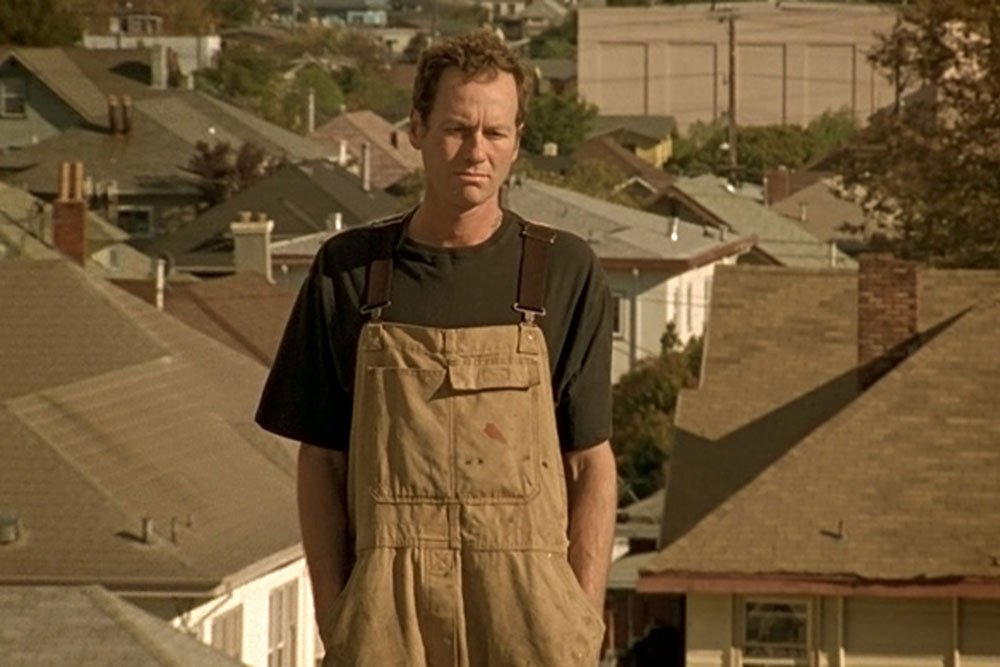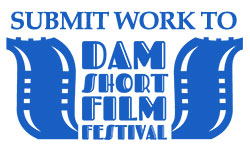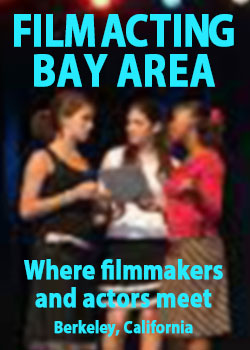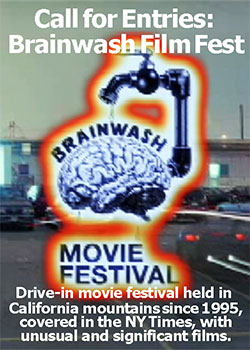Out of Oakland with a Bullet: Everything Strange and New
by Doniphan Blair
 Oakland everyman Jerry McDaniel stars in Frazer Bradshaw's startling new feature 'Everything Strange and New'. photo: courtesy F. BradshawFRAZER BRADSHAW IS AN UNASSUMING
Oakland everyman Jerry McDaniel stars in Frazer Bradshaw's startling new feature 'Everything Strange and New'. photo: courtesy F. BradshawFRAZER BRADSHAW IS AN UNASSUMING
guy of medium height, who lives in an unassuming neighborhood in a modest city, where he works as cinematographer and just finished a picture about which you should assume nothing.
First of all, that movie, "Everything Strange and New", just won the International Federation of Film Critics prize (FIPRESCI) at the San Francisco International Film Festival. Secondly, it was written and directed, as well as shot, by Bradshaw and it stars Bradshaw's nondescript neighborhood in North Oakland and the people who live there. Fortunately, all this averageness masks a profundity rarely probed in people's personalities or in the aesthetics of filmmaking. Like a Russian classic, "Everything Strange and New" keeps the slow burn coming 'til it takes you down to the bone.
"It has always been true of my work and I can't figure out why: People rarely hate it but they often don't get it either," Bradshaw told me the other day, sitting on the stoop of his modest house in that unassuming 'hood—little foot or car traffic, some houses unkempt, others lovely. "They either love it or they don't get it. The Chronicle said, 'It trades on cliché.' But most people, at least, say it was an original film."
Original also seems to be the consensus of the International Federation of Film Critics, who awarded "ESAN" the SF Film Festival prize, or Sundance's Trevor Groth, who called it "transcendent filmmaking that develops a cinematic language all its own." Or Peter Debruge, of Variety, who wrote that "ESAN" is a "semi-experimental symphony to the 21st-century man," and "as close to a time-capsule record of this moment in time as film can provide today."
"I went to great lengths to make my characters real. They have baggage but are not quirky," Bradshaw continued, after we moved inside to a neat, well-wainscoted living room but with some suspicious Martin guitars on the wall and balloons on the ceiling (his daughter had just celebrated her third birthday). "It takes place in anywhere America but it's also Oakland. The landscape plays a definite role—although it has no Oakland signifiers."
Nevertheless, there are long, intimate narrations by Jerry McDaniel—who plays Wayne, a recently married, somewhat adrift carpenter—over shots of Oakland. Not beauty shots, mind you, these are street corners, overpasses, cars driving, drawing a distinct connection between psyche and place. Like Jarmusch or Cassavetes, whose slow scenes of Americana eventually uncover wormy underbellies, when one of Bradshaw's innocuous street scenes starts rolling backwards—again, assume nothing.
Wayne's life remains relatively unscathed and blessedly average through the throes of economic downturn, two-kid responsibility and homoerotic experimentation. But his friends and family are spun by addiction, disease and even death—all handled in an unassuming way that fits into the film's flow and verisimilitude.
"I recognized, early on, that there was an intimacy that the audience could gain from spending time with the subject," says Bradshaw, in reference to his radical languor. "That intimacy would, ultimately, translate into an experience that the individual viewer would have of themselves. Fast cutting and action are just the opposite; they tend to keep the audience emotionally alienated from the subject."
Bradshaw is from Mobile, Alabama, but knew he "wanted to get the hell out by age 13." Into art from a young age, he actually spent his high school years attending the Alabama School of Fine Arts in Birmingham, where he received an advanced academic training. He came to San Francisco to attend the Art Institute, although he also got a merit scholarship to the Art Institute of Chicago. "I got both, and I chose SFAI, primarily because it was strictly focused on fine arts, without commercial art mixed in."
"I didn't learn a damn thing about how to make a movie at SFAI. But I learned a tremendous amount about what I had to say as an artist. Upon graduating, I quickly learned the basic technical skills that a film school will, generally, teach, but figuring out what one has to say... can't come from time on a film set. It can only come from being intimately engaged in a community of intelligent, broad-minded and working artists. If I had it to do all over again, I'd go back to SFAI."
Bradshaw learned his film tech to an extreme, however, as indicated by his stacks of camera cases, including an Aaton Super 16 and a Red, neat rows of lenses and dedication to film—the actual acetate and color dye. "I have done many tests, and film is way better if you are making a film about people. Video is sharper and cleaner, so it looks good on landscapes or car commercials, but on film, you see the personality. It's got better exposure, range and more color 'space.'"
Perhaps it's not that surprising, then, that the International Federation of Film Critics picked "ESAN". The film is quite European, from its slow emotional build to its endless jumble of rooftops, like a Juan Gris collage, and its soundtrack, the film's only over-the-top element. Composed by Dan Plonsey, it sounds like Irish jigs played by an orchestra on acid.
Yet "ESAN" remains totally Oakland, not only due to its dedication to both the ordinariness and vagaries of everyday life, but because it's an organic piece of art emerging from Bradshaw's experience. Following Leonardo's advice, he looked to the cracks in the wall for inspiration.
"When I started, I had no money, but I was going to make a feature one way or another. Since moving a crew around is expensive, I gave myself a limit: one mile from the house"—although there is one Lake Merritt shot, four miles away.
"I figured you could make a good movie for about $2,000 per screen minute, as long as you pull in all the favors. Since I was a cinematographer I knew a lot of people in the local business. I said to them: 'You know all that work I have been getting for you all these years?' But I would have used the same crew, even if I had ten times the budget." Still, "ESAN" is fully pro, with various levels of investors, points, and an LLC, a limited liability corporation, to receive the money.
"The seed money was cobbled together from family and out of my own pocket, but as I started moving forward, suddenly, as if by magic, Steve Bannatyne, the executive producer with Lucky Hat Entertainment, appeared."
Bradshaw has been advised not to divulge the final budget until getting a distributor, but he seems to have stuck to his estimated rate of $2,000 per minute (or just a bit over) for the 83-minute piece—a trick he was able pull off, in large part, by using everything and anything readily available to him, from his own Aaton camera to the story, scenery and crew. And now the environment has returned the favor: providing his first award.
Doniphan Blair is a writer, film magazine publisher, designer and filmmaker ('Our Holocaust Vacation'), who can be reached . Posted on Jun 22, 2009 - 02:27 AM
by Doniphan Blair
 Oakland everyman Jerry McDaniel stars in Frazer Bradshaw's startling new feature 'Everything Strange and New'. photo: courtesy F. Bradshaw
Oakland everyman Jerry McDaniel stars in Frazer Bradshaw's startling new feature 'Everything Strange and New'. photo: courtesy F. Bradshawguy of medium height, who lives in an unassuming neighborhood in a modest city, where he works as cinematographer and just finished a picture about which you should assume nothing.
First of all, that movie, "Everything Strange and New", just won the International Federation of Film Critics prize (FIPRESCI) at the San Francisco International Film Festival. Secondly, it was written and directed, as well as shot, by Bradshaw and it stars Bradshaw's nondescript neighborhood in North Oakland and the people who live there. Fortunately, all this averageness masks a profundity rarely probed in people's personalities or in the aesthetics of filmmaking. Like a Russian classic, "Everything Strange and New" keeps the slow burn coming 'til it takes you down to the bone.
"It has always been true of my work and I can't figure out why: People rarely hate it but they often don't get it either," Bradshaw told me the other day, sitting on the stoop of his modest house in that unassuming 'hood—little foot or car traffic, some houses unkempt, others lovely. "They either love it or they don't get it. The Chronicle said, 'It trades on cliché.' But most people, at least, say it was an original film."
Original also seems to be the consensus of the International Federation of Film Critics, who awarded "ESAN" the SF Film Festival prize, or Sundance's Trevor Groth, who called it "transcendent filmmaking that develops a cinematic language all its own." Or Peter Debruge, of Variety, who wrote that "ESAN" is a "semi-experimental symphony to the 21st-century man," and "as close to a time-capsule record of this moment in time as film can provide today."
"I went to great lengths to make my characters real. They have baggage but are not quirky," Bradshaw continued, after we moved inside to a neat, well-wainscoted living room but with some suspicious Martin guitars on the wall and balloons on the ceiling (his daughter had just celebrated her third birthday). "It takes place in anywhere America but it's also Oakland. The landscape plays a definite role—although it has no Oakland signifiers."
Nevertheless, there are long, intimate narrations by Jerry McDaniel—who plays Wayne, a recently married, somewhat adrift carpenter—over shots of Oakland. Not beauty shots, mind you, these are street corners, overpasses, cars driving, drawing a distinct connection between psyche and place. Like Jarmusch or Cassavetes, whose slow scenes of Americana eventually uncover wormy underbellies, when one of Bradshaw's innocuous street scenes starts rolling backwards—again, assume nothing.
Wayne's life remains relatively unscathed and blessedly average through the throes of economic downturn, two-kid responsibility and homoerotic experimentation. But his friends and family are spun by addiction, disease and even death—all handled in an unassuming way that fits into the film's flow and verisimilitude.
"I recognized, early on, that there was an intimacy that the audience could gain from spending time with the subject," says Bradshaw, in reference to his radical languor. "That intimacy would, ultimately, translate into an experience that the individual viewer would have of themselves. Fast cutting and action are just the opposite; they tend to keep the audience emotionally alienated from the subject."
Bradshaw is from Mobile, Alabama, but knew he "wanted to get the hell out by age 13." Into art from a young age, he actually spent his high school years attending the Alabama School of Fine Arts in Birmingham, where he received an advanced academic training. He came to San Francisco to attend the Art Institute, although he also got a merit scholarship to the Art Institute of Chicago. "I got both, and I chose SFAI, primarily because it was strictly focused on fine arts, without commercial art mixed in."
"I didn't learn a damn thing about how to make a movie at SFAI. But I learned a tremendous amount about what I had to say as an artist. Upon graduating, I quickly learned the basic technical skills that a film school will, generally, teach, but figuring out what one has to say... can't come from time on a film set. It can only come from being intimately engaged in a community of intelligent, broad-minded and working artists. If I had it to do all over again, I'd go back to SFAI."
Bradshaw learned his film tech to an extreme, however, as indicated by his stacks of camera cases, including an Aaton Super 16 and a Red, neat rows of lenses and dedication to film—the actual acetate and color dye. "I have done many tests, and film is way better if you are making a film about people. Video is sharper and cleaner, so it looks good on landscapes or car commercials, but on film, you see the personality. It's got better exposure, range and more color 'space.'"
Perhaps it's not that surprising, then, that the International Federation of Film Critics picked "ESAN". The film is quite European, from its slow emotional build to its endless jumble of rooftops, like a Juan Gris collage, and its soundtrack, the film's only over-the-top element. Composed by Dan Plonsey, it sounds like Irish jigs played by an orchestra on acid.
Yet "ESAN" remains totally Oakland, not only due to its dedication to both the ordinariness and vagaries of everyday life, but because it's an organic piece of art emerging from Bradshaw's experience. Following Leonardo's advice, he looked to the cracks in the wall for inspiration.
"When I started, I had no money, but I was going to make a feature one way or another. Since moving a crew around is expensive, I gave myself a limit: one mile from the house"—although there is one Lake Merritt shot, four miles away.
"I figured you could make a good movie for about $2,000 per screen minute, as long as you pull in all the favors. Since I was a cinematographer I knew a lot of people in the local business. I said to them: 'You know all that work I have been getting for you all these years?' But I would have used the same crew, even if I had ten times the budget." Still, "ESAN" is fully pro, with various levels of investors, points, and an LLC, a limited liability corporation, to receive the money.
"The seed money was cobbled together from family and out of my own pocket, but as I started moving forward, suddenly, as if by magic, Steve Bannatyne, the executive producer with Lucky Hat Entertainment, appeared."
Bradshaw has been advised not to divulge the final budget until getting a distributor, but he seems to have stuck to his estimated rate of $2,000 per minute (or just a bit over) for the 83-minute piece—a trick he was able pull off, in large part, by using everything and anything readily available to him, from his own Aaton camera to the story, scenery and crew. And now the environment has returned the favor: providing his first award.
Doniphan Blair is a writer, film magazine publisher, designer and filmmaker ('Our Holocaust Vacation'), who can be reached . Posted on Jun 22, 2009 - 02:27 AM























